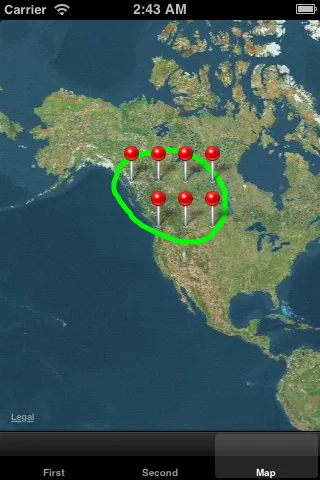在我的应用中,用户在地图上绘制形状,然后使用UIBeizerPath来绘制路径。然后根据路径的坐标显示仅在该区域内的结果。所有东西都很好,除了现在当注释放在地图视图上时,图钉看起来像是在路径后面,这意味着路径看起来在最前面。
我正在使用以下代码显示注释和路径:
我正在使用以下代码显示注释和路径:
-(void)clearAnnotationAndPath:(id)sender {
[_mapView removeAnnotations:_mapView.annotations];
path = [UIBezierPath bezierPath];
[shapeLayer removeFromSuperlayer];
}
- (void)handleGesture:(UIPanGestureRecognizer *)gesture
{
CGPoint location = [gesture locationInView:_pathOverlay];
if (gesture.state == UIGestureRecognizerStateBegan)
{
shapeLayer = [[CAShapeLayer alloc] init];
shapeLayer.fillColor = [[UIColor clearColor] CGColor];
shapeLayer.strokeColor = [[UIColor greenColor] CGColor];
shapeLayer.lineWidth = 5.0;
//[_mapView.layer addSublayer:shapeLayer];
[pathOverlay.layer addSublayer:shapeLayer];
path = [UIBezierPath bezierPath];
[path moveToPoint:location];
}
else if (gesture.state == UIGestureRecognizerStateChanged)
{
[path addLineToPoint:location];
shapeLayer.path = [path CGPath];
}
else if (gesture.state == UIGestureRecognizerStateEnded)
{
// MKMapView *mapView = (MKMapView *)gesture.view;
[path addLineToPoint:location];
[path closePath];
allStations = [RoadmapData sharedInstance].data;
for (int i=0; i<[allStations count]; i++) {
NSDictionary * itemNo = [allStations objectAtIndex:i];
NSString * fullAddress = [NSString stringWithFormat:@"%@,%@,%@,%@",[itemNo objectForKey:@"address"],[itemNo objectForKey:@"city"],[itemNo objectForKey:@"state"],[itemNo objectForKey:@"zip"]];
CLGeocoder * geoCoder = [[CLGeocoder alloc]init];
[geoCoder geocodeAddressString:fullAddress completionHandler:^(NSArray *placemarks, NSError *error) {
if (error) {
NSLog(@"Geocode failed with error: %@", error);
return;
}
if(placemarks && placemarks.count > 0)
{
CLPlacemark *placemark = placemarks[0];
CLLocation *location = placemark.location;
CLLocationCoordinate2D coords = location.coordinate;
CGPoint loc = [_mapView convertCoordinate:coords toPointToView:_pathOverlay];
if ([path containsPoint:loc])
{
NSString * name = [itemNo objectForKey:@"name"];
stationAnn = [[LocationAnnotation alloc]initWithCoordinate:coords Title:name subTitle:@"Wells Fargo Offer" annIndex:i];
stationAnn.tag = i;
[_mapView addAnnotation:stationAnn];
}
else{
NSLog(@"Out of boundary");
}
}
}];
[self turnOffGesture:gesture];
}
}
}
- (void)mapView:(MKMapView *)aMapView didAddAnnotationViews:(NSArray *)views{
if (views.count > 0) {
UIView* firstAnnotation = [views objectAtIndex:0];
UIView* parentView = [firstAnnotation superview];
if (_pathOverlay == nil){
// create a transparent view to add bezier paths to
pathOverlay = [[UIView alloc] initWithFrame: parentView.frame];
pathOverlay.opaque = NO;
pathOverlay.backgroundColor = [UIColor clearColor];
[parentView addSubview:pathOverlay];
}
// make sure annotations stay above pathOverlay
for (UIView* view in views) {
[parentView bringSubviewToFront:view];
}
}
}
另外,当我返回并查看后,它甚至没有绘制路径。
请帮忙。
谢谢。

pathOverlay的四行初始化代码添加到你的视图控制器的viewDidLoad:方法中即可。我之前的实现方式是为了实现懒加载并减少需要展示的代码量。但是,你也可以在整个视图层次结构加载时初始化pathOverlay。另外,如我之前所说,请确保pathOverlay是一个属性,而不仅仅是一个ivar。如果你想要更加安全,请确保它被保留(@property (nonatomic, strong) UIView* pathOverlay;,或者对于非ARC代码,使用@property (nonatomic, retain) UIView* pathOverlay;)。 - Nate@property声明,然后在.m文件中使用@synthesize合成它。正如我所说,它也应该是保留或strong。 - Nate